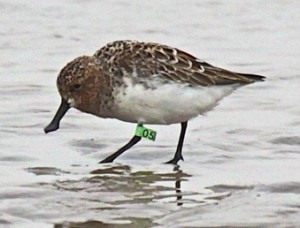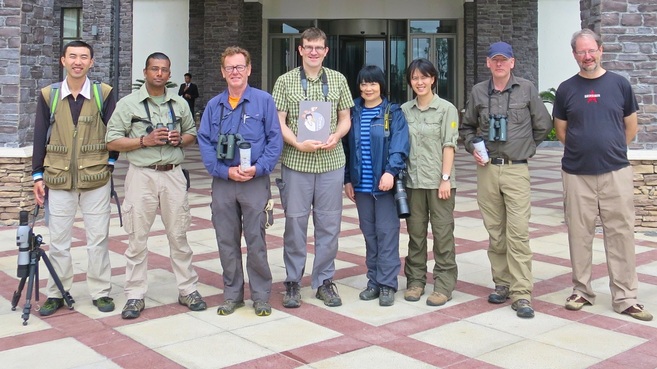Posted on: June 29, 2014
Report by Bushwings

Giant Turbines cross the landscape and stretch far out into the Yellow Sea dwarfing us on the mudflats
Twenty minutes after high tide on the 2nd May 2014, I stepped onto the mudflats at Dongtai, Rudong, north east of Shanghai. For the next twenty-two days our mission was to search for the highly endangered Spoon-billed Sandpiper. The tide here retreats at walking pace away from a massive artificial seawall that now blocks the tidal flow from marginal wetlands. These are wetlands used by waders for roosting at high tide. Within a few years these wetlands will become reclaimed land and the roosting sites may disappear unless there is concerted conservation action.
I was with Guy Anderson, manager of research at the Royal Society for The Protection of Birds (UK) along with James Phillips and Adam Gretton from the organization, Natural England, and Andrew Baksh from New York. With expert local support from Zhang Lin and coordination by Jing Li we were the Rudong team for the 2014 China Coastal Waterbird Census.
Three hundred metres out from the seawall I focused my scope on water pools and their wet margins and scanned through flocks of Red-Necked Stint and Dunlin. I had never seen a ‘Spoonie’ except in a field guide. This is methodical work. To the untrained eye ‘Spoonies’ can look similar to other small waders until the bill is spotted. With experience, the moulting plumage that distinguishes them from Red-necked Stint becomes a key feature to look for in a dense mixed flock when the bill can’t be seen.
After forty minutes one was in my scope. It had a lime green flag on the upper left leg with the numeric ‘05’. It was feeding energetically by pecking lightly on the mud surface. Spoon-billed Sandpipers’ bill sweeping motion seems only to occur when in shallow water. In 2013 just eight Spoon-billed Sandpipers caught on their nesting grounds were flagged with lime green numeric flags.
Pavel Tomkovich from the Department of Ornithology, Zoological Museum, Moscow State University reported to us on the history of ‘Lime 05’. It is a female caught on her nest near Meinypilgyno Village, southern Chukotka, Russian Far East, on 20 June 2013 (band no.: MOSKVA KS18825). Her eggs were taken for artificial incubation and captive chick rearing before release on the breeding grounds as part of the Head Start Project. This bird then successfully produced a second brood on the nest. Later ‘Lime 05’ was observed and photographed on its wintering grounds at Khok Kham, Samut Sakhon Province, Inner Gulf of Thailand on 30 November 2013 where it remained until at least 6 March 2014.
We estimated the effort needed to find a Spoon-billed Sandpiper on Rudong’s mudflats involved scanning approximately 6000 small waders to find one Spoon-billed Sandpiper. Approximately 115 sightings were made and it is likely this represented about 41 individual birds; two with flags, 04 and 05. Our estimate of individual birds was based on careful study of differences in breeding plumage. Learning to rate breeding plumage takes time and is enhanced by constant collegiate consultation, review of photographs and referral to plumage charts provide by the Spoonbill Sandpiper Taskforce.
Monitoring of the intertidal mudflats and roosting wetlands in Rudong re-confirms this coastal region is a vital staging point for the highly threatened Spoonbill Sandpiper on migration to its breeding grounds around Chukotka in far Eastern Russia.
Jing Li, China coordinator for the Coastal Waterbird Census tells me she hopes more overseas birders from across the flyway and beyond will join the survey teams along Yellow Sea coastline, including Rudong, in the future. Being on the mudflats at Rudong for 6 to 8 hours a day is a tough business but a highly rewarding one. And, off the mud, the woods and grasslands close to the coast have the most outstanding passerine passage migrants in the spring and autumn. We made sure there was always time to check out what passerines are passing through this rapidly changing region.
Original Link: http://bushwings.weebly.com/blog/searching-for-spoonies-in-rudong-china






